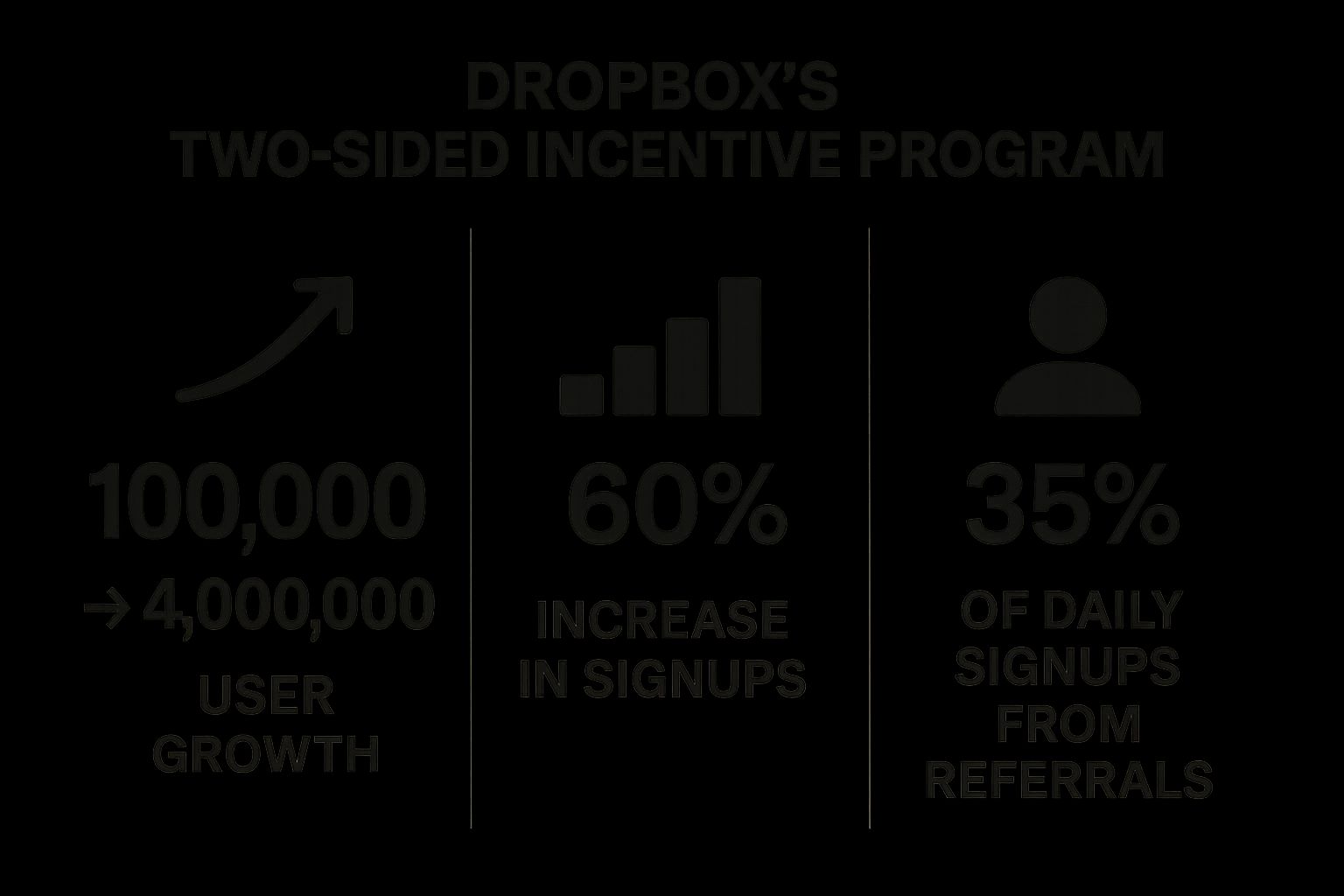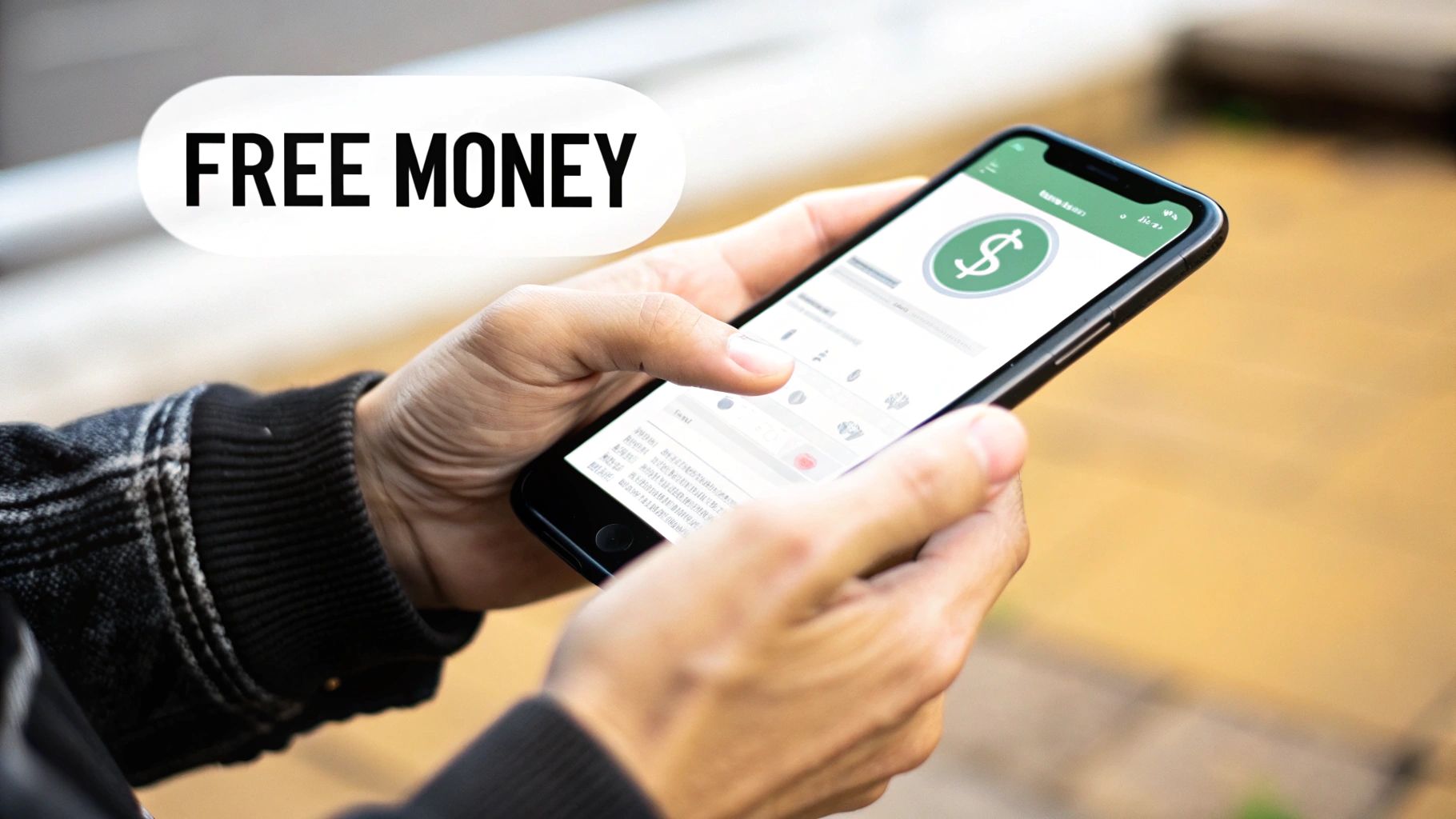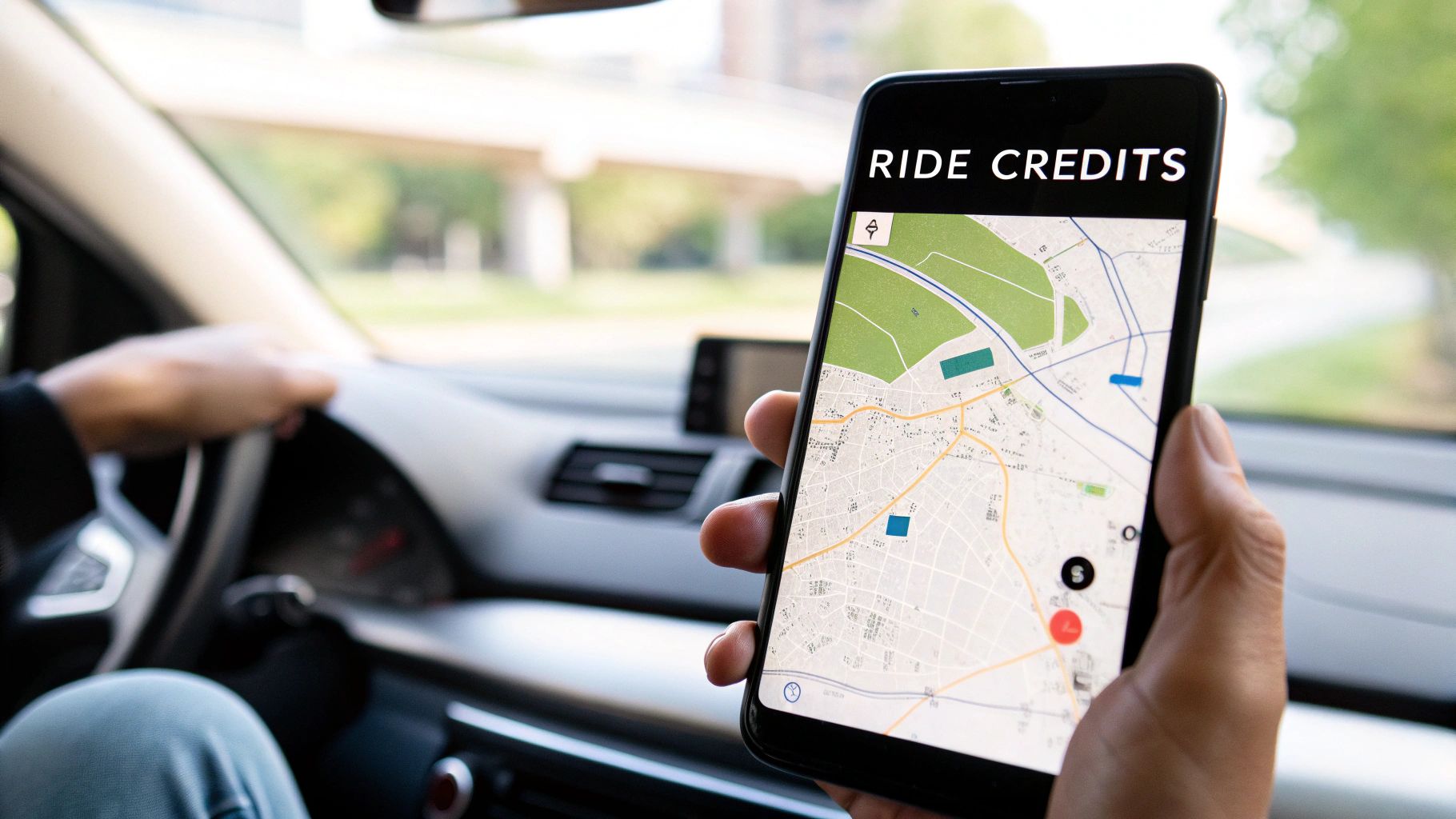Referral Marketing: Learn from the Best
Want to boost customer acquisition and slash marketing costs? Referral marketing is your answer. This listicle provides six proven referral marketing examples to inspire your strategy. Learn how companies like Dropbox, Airbnb, PayPal, Tesla, Harry's, and Uber built successful referral programs. These examples illustrate effective reward structures and key takeaways for your own campaign. We'll also cover how Refgrow can simplify integrating a referral program into your SaaS product.
1. Dropbox's Two-Sided Incentive Program
Dropbox's referral program stands as a quintessential referral marketing example, showcasing the power of incentivizing both the referrer and the referee. This two-sided incentive approach offered existing users extra storage space for every friend they brought onboard, and the referred friends also received the same bonus. This mutually beneficial system fueled remarkable growth, transforming Dropbox from a relatively unknown service with 100,000 users to a file-sharing giant boasting 4 million users in just 15 months. This strategy proved particularly effective for early-stage startups and product-led growth SaaS companies looking to quickly expand their user base.

The infographic above visualizes the explosive growth Dropbox experienced due to its referral program. The key statistics highlighted – a 60% increase in signups with 35% of daily signups stemming from referrals – demonstrate the program's remarkable impact. These numbers underscore the program's effectiveness in driving user acquisition at a fraction of the cost of traditional marketing, proving particularly valuable for self-serve SaaS companies and indie hackers with limited budgets. This rapid growth solidified Dropbox's position as a leading cloud storage provider and established their referral program as a case study for SaaS referral marketing.
The program's success can be attributed to several key features. The simple interface allowed users to easily share referral links via email or social media, while tiered rewards motivated continued sharing by allowing users to accumulate up to 16GB of free storage. Furthermore, clear tracking of referral status kept users engaged and informed about their progress. This seamless integration of the referral program within the product experience leveraged Dropbox’s natural product-market fit for sharing functionality.
Pros:
- Exponential User Growth: The program propelled Dropbox from 100,000 to 4 million users in just 15 months.
- Low Customer Acquisition Cost: Referrals proved significantly more cost-effective than traditional advertising, saving millions.
- Increased Engagement: The incentive, directly tied to product usage (storage space), encouraged higher engagement from both referrers and referees.
- Organic Brand Advocacy: The mutually beneficial system naturally turned users into brand advocates.
- High Conversion Rates: Referral marketing delivered higher conversion rates compared to traditional advertising.
Cons:
- Market Saturation: The program eventually reached saturation among early adopters.
- Cost of Rewards: Giving away substantial product value (storage space) represented a significant expense.
- Maintenance Costs: Maintaining the program became increasingly expensive as the user base expanded.
- Limited Referral Actions: The program was limited to a one-time referral action per relationship.
Learn more about Dropbox's Two-Sided Incentive Program
Tips for Implementing a Similar Program:
- Valuable & Sustainable Rewards: Ensure rewards are attractive enough to motivate sharing but remain sustainable for your business.
- Frictionless Process: Make the referral process extremely simple and user-friendly.
- In-Product Integration: Integrate referral options directly within the product experience.
- Conversion Tracking: Track and optimize referral conversion paths.
- Leverage Sharing Potential: Consider your product's natural sharing potential when designing incentives.
Dropbox's referral program, popularized by Drew Houston and Sean Ellis, is a prime example of how a well-designed, two-sided incentive program can drive explosive growth. By understanding its key features, benefits, and potential drawbacks, SaaS founders and indie hackers can learn valuable lessons for implementing their own successful referral marketing campaigns. This referral marketing example demonstrates the potential for rapid growth and low-cost customer acquisition when the incentive aligns seamlessly with the product and its user base.
2. Airbnb's Travel Credit Referral System
Airbnb's Travel Credit Referral System stands as a prime referral marketing example, demonstrating how a well-executed program can drive significant growth. This system offers travel credits to both the referrer (existing user) and the referred friend when the friend completes a qualifying stay or experience. This two-sided incentive structure, typically offering credits between $25 and $75, leverages the inherent network effect of travel and accommodation. Airbnb’s program hasn't been static; it's been continuously refined through data analysis and user behavior patterns, a testament to its commitment to optimizing for growth. This makes it a particularly relevant referral marketing example for early-stage startups, self-serve SaaS companies, product-led growth SaaS, SaaS founders, and indie hackers looking to scale their user base.
How it Works:
The system operates on a simple premise: reward both parties for successful referrals. Existing users receive a personalized referral link and can customize messages to share via email, social media, or direct link. The platform provides in-app and email referral tracking, allowing users to monitor the status of their referrals. Once the referred friend completes a qualifying stay or experience, both parties receive their travel credits. Airbnb also incorporates qualification requirements for credit redemption and localizes rewards based on market value, demonstrating an understanding of diverse market dynamics.
Examples of Success:
Airbnb has witnessed remarkable success with its referral program. They reported a 300% year-over-year growth in some markets following implementation and even achieved a staggering 900% year-over-year growth in certain emerging markets. The program has generated millions in new bookings through referred customers at a significantly lower customer acquisition cost than traditional digital advertising, proving its effectiveness as a sustainable growth engine. This success is particularly inspiring for startups looking for cost-effective user acquisition strategies.
Pros:
- High Growth: Proven track record of driving substantial year-over-year growth.
- Higher Booking Value: Referred customers tend to have a higher average booking value.
- Increased User Acquisition: Effective in both existing and new markets.
- Higher Retention Rates: Trust-based acquisition leads to improved user retention.
- Aligned Incentives: Rewards high-value customer actions (completing stays).
Cons:
- Complex Administration: Managing across multiple currencies and markets can be challenging.
- Optimization Required: Finding the optimal reward amounts requires thorough testing.
- Credit Expiration: Expiring credits can create friction for users.
- Fraud Potential: Requires robust security measures to prevent fraudulent activity.
Tips for Implementation:
- Test Reward Values: Experiment with different reward amounts to find the sweet spot that maximizes referrals without significantly impacting profitability.
- Seamless Experience: Ensure a smooth referral process across both mobile and desktop platforms.
- Fraud Prevention: Implement fraud prevention measures without adding unnecessary friction to the user experience.
- Personalized Messaging: Tailor referral messages to resonate with the target audience and increase conversion rates.
- Dynamic Rewards: Consider offering higher rewards for high-value markets or peak seasons.
When and Why to Use This Approach:
This referral marketing example is particularly effective for businesses with a strong network effect, where the value of the product or service increases with the number of users. It's ideal for companies operating in industries like travel, hospitality, and other platform-based businesses. The two-sided incentive structure ensures both the referrer and the referred friend benefit, maximizing engagement and encouraging participation. This strategy is especially valuable for early-stage startups and SaaS companies looking for sustainable and cost-effective customer acquisition channels. It provides a strong foundation for organic growth, especially when coupled with a product-led growth strategy.
Key Figures:
Brian Chesky (Airbnb co-founder and CEO), Gustaf Alströmer (Former Airbnb Growth Product Lead), and Jason Bosinoff (Airbnb Engineering) have all been instrumental in popularizing and refining Airbnb's referral program.
This referral marketing example showcases how a well-designed program can significantly contribute to a company's growth trajectory. By leveraging trust, incentivizing desired actions, and continuously optimizing based on data, Airbnb has created a referral system that serves as a powerful model for other businesses aiming to harness the power of word-of-mouth marketing.
3. PayPal's Cash Incentive Growth Strategy
PayPal's early referral program is a legendary referral marketing example in the tech world, demonstrating the power of direct cash incentives for rapid user acquisition. Facing a competitive landscape in the nascent days of online payments, PayPal needed a strategy to quickly build a critical mass of users. Their solution? Cold, hard cash. New users received $10 just for signing up, and another $10 for each friend they referred. This straightforward value proposition – free money – proved incredibly effective.

This double-sided incentive structure, coupled with an easy-to-understand email-based referral mechanism, fueled explosive growth. At its peak, PayPal achieved a staggering 7-10% daily growth rate, a testament to the program's effectiveness. This aggressive approach allowed them to acquire over 100 million users and establish market dominance, paving the way for their eventual acquisition by eBay for $1.5 billion. This referral marketing example highlights the potential of incentivized growth, especially for financial products where building trust and achieving network effects are crucial.
This strategy deserves a place on this list because it showcases how a simple, yet aggressive, referral program can dramatically accelerate growth, even in a crowded market. Key features included direct cash rewards for both referrers and new users, an extremely simple value proposition, and an email-based referral system. As growth accelerated, the initial $20 referral bonus was strategically reduced to $10, then $5, to manage costs.
Pros:
- Achieved 7-10% daily user growth at its peak.
- Built a massive user base of over 100 million accounts.
- Created a strong network effect that became self-sustaining.
- Established a market-leading position ahead of competitors.
- Extremely high conversion rates compared to traditional marketing.
Cons:
- High cost: The program cost PayPal an estimated $60-70 million in payouts.
- Attracted some low-quality users primarily interested in the bonus, not the product's long-term value.
- Created a growth spike that proved difficult to maintain after the initial program.
- Required scaling back of incentives as costs became unsustainable.
- Faced fraud challenges, necessitating additional security measures.
Examples of Success:
- Reached over 100,000 users within the first month of the referral program.
- Achieved exponential growth, exceeding 100 million accounts.
- Established the critical mass necessary for the $1.5 billion eBay acquisition.
- Set a new standard for aggressive growth marketing, especially in fintech.
Tips for Implementation:
- Calculate Customer Lifetime Value (CLTV): Determine a sustainable incentive amount based on your projected CLTV. Don't give away more than you can afford to recoup over a customer's lifetime.
- Plan for Scalability: Design your program with future adjustments in mind. Be prepared to scale back rewards as growth accelerates to maintain profitability.
- Implement Anti-Fraud Measures: Proactive fraud prevention is crucial, especially with cash incentives. Implement robust security measures from the outset.
- Consider Cash Incentives for Financial Products: Direct cash rewards can be particularly effective for financial products where trust and initial adoption are key hurdles.
- Focus on Core Product Value: Ensure your product delivers real value beyond the initial incentive. Users acquired through incentives should find enough value to remain engaged even after the rewards are reduced or eliminated.
Popularized By: Peter Thiel (PayPal co-founder), Elon Musk (PayPal co-founder), David Sacks (PayPal COO), and the 'PayPal Mafia'.
This referral marketing example provides valuable lessons for early-stage startups, self-serve SaaS companies, product-led growth SaaS, SaaS founders, and indie hackers looking to rapidly scale their user base. While the aggressive cash incentive model may not be sustainable for every business, PayPal’s success demonstrates the potential of leveraging referrals for explosive growth, especially when combined with a clear value proposition and robust execution.
4. Tesla's Tiered Referral Program: A Referral Marketing Example
Tesla's referral program stands out as a prime referral marketing example, demonstrating how innovative rewards and gamification can drive significant growth. Instead of relying on traditional advertising, Tesla leveraged the enthusiasm of its existing customer base to acquire new customers, turning them into powerful brand ambassadors. This approach is particularly relevant for early-stage startups, self-serve SaaS companies, product-led growth SaaS, SaaS founders, and indie hackers looking for cost-effective, scalable customer acquisition strategies.
Tesla's program wasn't just a simple "refer-a-friend" discount. It was a dynamic, tiered system that offered increasingly valuable rewards for multiple referrals. This gamified approach, complete with leaderboards and achievement tracking within the Tesla mobile app, fostered a sense of community and competition among owners.
How it Worked:
The program's core revolved around tiered rewards. Referrers could earn credits applicable to new vehicles, solar products, and accessories. The more referrals, the more valuable the rewards. But Tesla didn't stop at discounts. They offered truly unique incentives, from exclusive access to events and merchandise to the chance to launch personal photos into space with SpaceX. These limited-edition rewards, unavailable through any other means, tapped into the desires of Tesla enthusiasts and created a powerful viral effect.
Examples of Success:
- Massive ROI: During peak performance, Tesla's referral program generated an estimated 40x return on investment. This demonstrates the power of leveraging existing customers for acquisition.
- Organic Growth: The program fueled thousands of vehicle sales without relying on traditional advertising, a significant achievement, particularly in the competitive automotive market.
- Community Building: The program helped cultivate a strong community of brand ambassadors who actively promoted Tesla products.
- Viral Marketing: Unconventional rewards, like the SpaceX launch opportunity, generated significant media attention and viral sharing, further amplifying the program's reach. Top referrers even earned a free Tesla Roadster (worth $250,000), demonstrating the program's potential for high-value rewards.
Pros:
- Cost-effective customer acquisition compared to traditional advertising.
- High conversion rates due to trusted recommendations.
- Strong brand community building.
- Reinforces premium brand positioning through exclusive rewards.
Cons:
- Program costs can escalate with high-value rewards.
- Frequent program changes can lead to customer confusion.
- Administrative complexity in managing custom rewards.
- Fulfillment challenges for certain rewards (e.g., prioritizing Powerwall installations).
Tips for Implementation:
- Align Rewards with Brand Identity: Offer exclusive, limited-edition rewards that resonate with your target audience and reinforce your brand values. Don't just default to cash discounts. Think about what truly motivates your customers.
- Tiered Structure: Implement a tiered reward system to encourage multiple referrals and reward loyal advocates.
- Regular Refresh: Keep the program fresh and exciting by periodically introducing new incentives and rewards. This maintains engagement and prevents stagnation.
- Careful Cost Calculation: Thoroughly analyze the program's economics, particularly when offering high-value rewards. Ensure the cost of acquisition remains sustainable.
- Leverage Existing Enthusiasts: Focus on activating your existing customer base rather than solely incentivizing new customers. Your most loyal customers are your best advocates.
When to Use This Approach:
This referral marketing model is especially effective for businesses with:
- Strong Brand Community: If you have a passionate customer base, a referral program can amplify their enthusiasm and turn them into active promoters.
- Unique Product/Service: Offering a unique product or service allows for more creative and compelling referral rewards.
- Focus on Product-Led Growth: Referral programs can be a powerful engine for product-led growth, driving organic adoption through word-of-mouth marketing.
Tesla's referral program deserves its place on this list because it demonstrates the power of creativity and gamification in referral marketing. By offering exclusive, aspirational rewards, Tesla transformed its customers into passionate advocates, achieving remarkable growth with minimal reliance on traditional advertising. This is a valuable lesson for any business, especially startups and SaaS companies, looking to achieve sustainable and cost-effective customer acquisition.
5. Harry's Pre-launch Referral Campaign: A Masterclass in Referral Marketing
This referral marketing example showcases the power of pre-launch campaigns. Harry's, the popular men's grooming company, executed a brilliant pre-launch referral program that generated massive buzz and a substantial email list before their product even hit the market. This strategy is a powerful demonstration of how referral marketing can be used not just for customer acquisition post-launch, but also for building anticipation and a ready-made customer base. This makes it a particularly relevant referral marketing example for early-stage startups, self-serve SaaS companies, product-led growth SaaS, SaaS founders, and indie hackers looking to make a splash upon entry.
So how did they do it? Harry's created a simple, two-page microsite with a clear value proposition: refer friends, earn free products. This simplicity was key to the campaign's success. The tiered reward system incentivized sharing: referring five friends unlocked free shave cream, while ten referrals earned a free razor, and so on. A progress bar visually tracked referral progress, further motivating participants to share. Seamless social sharing integration with pre-written messages made it effortless for users to spread the word.
This pre-launch approach delivered outstanding results. Harry's collected an astounding 100,000 email addresses in just one week – all without having any product inventory. This eliminated the risk associated with producing goods before gauging demand. The campaign created significant anticipation and buzz, which translated into immediate revenue upon product launch. Remarkably, 77% of email addresses were gathered through referrals, demonstrating the inherent virality of the campaign. The minimal technical implementation cost of under $300 further underscores the efficiency of this strategy. Learn more about Harry's Pre-launch Referral Campaign
Key Features and Benefits:
- Pre-launch implementation: Generates buzz and collects leads before product availability.
- Simple microsite: Easy to understand and navigate, maximizing conversion rates.
- Tiered rewards: Incentivizes sharing and drives viral growth.
- Progress bar: Encourages continued participation and referral activity.
- Social sharing integration: Facilitates easy sharing with pre-written messages.
- Email collection focus: Builds a valuable marketing asset for future communication.
Pros:
- Rapid email list growth (100,000 in one week).
- Zero product inventory risk.
- Pre-launch buzz and anticipation.
- Low implementation cost.
- Built-in virality.
Cons:
- Pressure to meet high post-launch expectations.
- Initial revenue impact due to free product giveaways.
- Limited demographic data collection compared to other methods.
- Initially a one-time campaign (though Harry's has since implemented an ongoing referral program).
Actionable Tips for Implementing a Similar Campaign:
- Simplicity is Key: Keep the referral mechanism incredibly easy to understand and participate in, especially for pre-launch campaigns.
- Achievable Reward Tiers: Design rewards that are attainable but still require some effort, striking a balance between motivation and exclusivity.
- Visual Progress Indicators: Use progress bars or other visual cues to show users how close they are to earning rewards.
- Frictionless Social Sharing: Integrate social sharing buttons with pre-written messages to make sharing as easy as possible.
- Maintain Engagement: Follow up with referrers to keep them engaged and excited about the upcoming launch.
The Harry's pre-launch referral campaign became a case study for a reason. It perfectly demonstrates how a simple, well-executed referral program can generate immense value even before a product is available. Popularized by Harry's co-founders Jeff Raider and Andy Katz-Mayfield, and further amplified by figures like Tim Ferriss and platforms like Shopify (which was used for the campaign's implementation), this referral marketing example offers valuable lessons for any business seeking to leverage the power of referrals for explosive growth.
6. Uber's Dual-sided Ride Credit Program
Uber's dual-sided ride credit program stands as a prime referral marketing example, demonstrating how a simple yet powerful incentive can fuel explosive growth. This program, instrumental in propelling Uber to over 100 million users worldwide, offered ride credits to both the referrer (existing user) and the referred friend (new user). This two-sided incentive tapped into an immediate need – convenient transportation – and provided an immediate reward – free or discounted rides. The clear value proposition and seamless in-app integration made sharing referral codes a natural part of the Uber experience.

The program's success stemmed from several key features: personalized referral codes for effortless sharing, a dedicated in-app referral center with tracking capabilities, diverse sharing options (text, email, social media), and geographically tailored reward amounts based on market dynamics. Uber also leveraged time-limited promotions to boost growth in new markets. For early-stage startups, self-serve SaaS companies, and product-led growth SaaS, Uber's approach showcases the potential of referral programs to drive rapid user acquisition. SaaS founders and indie hackers can learn valuable lessons from this model, especially regarding leveraging network effects and incentivizing existing users.
This program's impact on Uber's growth is undeniable. It contributed significantly to achieving 38% month-over-month growth during expansion periods, with referrals accounting for a substantial percentage of first-time riders in new markets. The program was successfully replicated across 700+ cities globally. Moreover, referred users exhibited higher retention rates compared to those acquired through other channels, translating to lower customer acquisition costs than traditional advertising methods. Uber even strategically used increased referral values to counter competitive moves from rivals like Lyft. Learn more about Uber's Dual-sided Ride Credit Program
However, Uber's referral program wasn't without its challenges. The company faced significant fraud attempts, requiring robust security measures. Referral values needed constant adjustment as markets matured, and program economics shifted as competition intensified. Different regulatory environments also complicated global implementation, and the program eventually reached saturation in established markets.
Despite these challenges, the program serves as a powerful referral marketing example. For those looking to implement similar strategies, here are some actionable tips: Adjust referral values based on market maturity and competition; seamlessly integrate the referral process into the user journey, ensuring redemption is automatic and frictionless; consider offering higher referral values for high-priority growth markets; and implement strong analytics to track referral effectiveness across different channels and user segments. This approach is particularly effective when you’re trying to establish a network effect, especially in a new market. The dual-sided incentive creates a win-win for both parties, encouraging participation and driving rapid growth.
This referral marketing example deserves its place on this list because it demonstrates how a well-designed program can drive rapid growth, lower acquisition costs, and build a loyal user base. The key takeaways for businesses are the importance of a clear value proposition, seamless integration, and ongoing optimization based on market dynamics and competitive pressures.
Referral Marketing Program Comparison
| Program Title | Implementation Complexity 🔄 | Resource Requirements ⚡ | Expected Outcomes 📊 | Ideal Use Cases 💡 | Key Advantages ⭐ |
|---|---|---|---|---|---|
| Dropbox's Two-Sided Incentive | Moderate: simple referral links, tracking | Medium: storage space cost, infrastructure | High: 60% signup increase, viral growth to 4M users | SaaS products with shareable features | Mutual rewards increase engagement, low CAC |
| Airbnb's Travel Credit Referral | High: multi-market, currency handling | High: credits cost, anti-fraud, localization | Very High: 300%-900% growth, higher booking values | Travel & service platforms with high-value actions | Aligned with purchase behavior, strong retention |
| PayPal's Cash Incentive Strategy | Low-Medium: simple cash payouts via email | Very High: significant cash payouts | Very High: 7-10% daily growth, 100M+ users | Financial services needing rapid trust building | Fast user acquisition, strong network effects |
| Tesla's Tiered Referral Program | High: complex reward tiers, gamification | High: exclusive rewards, fulfillment complexity | High: thousands of sales, strong brand ambassadors | Premium products with enthusiastic fanbase | Unique, exclusive rewards, brand strengthening |
| Harry's Pre-launch Campaign | Low: simple microsite & email collection | Low: minimal cost, technical simplicity | High: 100K emails in 1 week, strong pre-launch buzz | Startups launching new products | Zero inventory risk, fast buzz generation |
| Uber's Dual-sided Ride Credit | High: geo-tailoring, fraud prevention | High: ride credit costs, global scaling | Very High: 38% monthly growth, 100M+ users | Service apps with immediate user rewards | Seamless integration, rapid global scale |
Ready to Launch Your Own Referral Program?
From Dropbox's ingenious two-sided incentives to Harry's pre-launch buzz-building campaign, the referral marketing examples we've explored demonstrate the power of leveraging existing customers to drive growth. Key takeaways include understanding your target audience, crafting compelling incentives, and making referrals easy to share. Whether it's a cash reward like PayPal or a tiered system like Tesla, the right approach depends on your specific product and customer base. Mastering these concepts can be the catalyst for significant customer acquisition, reduced marketing spend, and ultimately, a thriving business.
Want to amplify your referral program's reach? Consider leveraging the power of Threads. Building a strong presence on the platform can significantly boost your visibility and attract new customers. Explore proven strategies for growing a Threads following from Schedul to maximize your social impact.
By learning from successful referral marketing examples like the ones detailed here—from Airbnb’s travel credits to Uber’s dual-sided ride program—you're setting the stage for sustainable growth. Ready to streamline your referral program implementation? Refgrow offers a seamless way to build and integrate powerful referral systems directly within your product. Visit Refgrow to discover how you can launch a cutting-edge referral program with a single line of code and unlock the full potential of your customer network.

